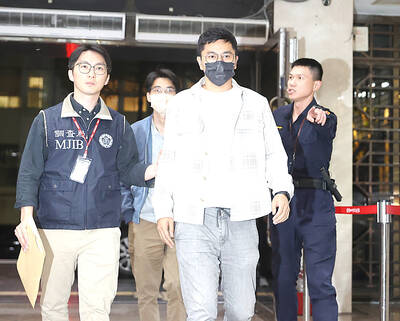China and South Korea issued a joint call for the denuclearization of the Korean Peninsula at a summit in Seoul yesterday that was seen as a pointed snub of nuclear-armed North Korea by chief ally Beijing.
In a joint statement after their talks, Chinese President Xi Jinping (習近平) and South Korean President Park Geun-hye reaffirmed their “firm opposition” to the development of nuclear weapons on the peninsula, but seemed divided on how best to persuade the North to give up its bombs.
While Park told reporters that the two sides had agreed to use “all means” possible to bring denuclearization about, Xi said that “dialogue and negotiation” were the best way forward.
“There was certainly a difference in perspectives, but that has always been there,” said Yang Moo-jin, a professor at the University of North Korean Studies. “South Korea might have liked Xi to say something more direct toward the North, but that was wishful thinking.”
If the joint statement marked no departure from established Chinese and South Korean policy toward North Korea, the fact that it was released at a summit in Seoul carried significant symbolic weight.
It was Xi’s first trip as head of state to the perennially volatile Korean Peninsula and his second summit with Park, who visited China last year.
With North Korean leader Kim Jong-un still waiting for an invitation to Beijing, Xi’s decision to visit Seoul before Pyongyang was seen as a calculated rebuff that spoke to the strained relationship between Pyongyang and its historic and most important ally.
“No previous Chinese leader has put South Korea before and above the North like this,” said Aidan Foster-Carter, a Korea expert at Britain’s Leeds University.
In what some saw as a display of pique at Xi’s visit, North Korea had conducted a series of rocket and missile launches over the past week, and pledged further tests in the future.
Seoul had been hoping that yesterday’s joint statement would include a strongly worded warning to Pyongyang, but analysts had forecast that Beijing was unlikely to up the rhetorical ante by any significant degree.
It made no mention of North Korea’s nuclear tests, although in her comments afterwards, Park said both sides had reaffirmed their “resolute opposition” to any further testing.
The statement did stress the importance of finding a way to get the long-stalled six-party talks on North Korea up and running again.
Beijing has pushed for a resumption of the six-party process — involving the two Koreas, China, the US, Japan and Russia, but Seoul and Washington insist that Pyongyang must first make a tangible commitment to abandoning its nuclear weapons program.
As the North’s diplomatic protector and chief economic benefactor, China has repeatedly been pressured by the international community to use its leverage to rein in Pyongyang’s nuclear ambitions, but while Beijing has become increasingly frustrated with the North’s missile and nuclear tests, it remains wary of penalizing the isolated state too heavily.
It is especially anxious to avoid any regime collapse that would result in a unified Korea with a US troop presence on its border.
Washington has played up Xi’s two-day visit as evidence of Pyongyang’s deepening diplomatic isolation.
“The symbolism of a visit by a Chinese leader to Seoul against the backdrop of tensions between North Korea and its neighbors ... is pretty striking,” US Assistant Secretary of State Daniel Russel said.
The wider background to Xi’s trip includes China’s response to the US “pivot to Asia” and the battle between the two major powers for regional influence.
China is currently South Korea’s largest export market and two-way trade stood at about US$275 billion last year, but analysts say Beijing wants to move beyond economic ties, and promote political and security links. That leaves Seoul with a difficult balancing act, given its historic military alliance with the US.
There are about 29,000 US troops stationed in South Korea.

Seventy percent of middle and elementary schools now conduct English classes entirely in English, the Ministry of Education said, as it encourages schools nationwide to adopt this practice Minister of Education (MOE) Cheng Ying-yao (鄭英耀) is scheduled to present a report on the government’s bilingual education policy to the Legislative Yuan’s Education and Culture Committee today. The report would outline strategies aimed at expanding access to education, reducing regional disparities and improving talent cultivation. Implementation of bilingual education policies has varied across local governments, occasionally drawing public criticism. For example, some schools have required teachers of non-English subjects to pass English proficiency

‘FORM OF PROTEST’: The German Institute Taipei said it was ‘shocked’ to see Nazi symbolism used in connection with political aims as it condemned the incident Sung Chien-liang (宋建樑), who led efforts to recall Democratic Progressive Party (DPP) Legislator Lee Kun-cheng (李坤城), was released on bail of NT$80,000 yesterday amid an outcry over a Nazi armband he wore to questioning the night before. Sung arrived at the New Taipei City District Prosecutors’ Office for questioning in a recall petition forgery case on Tuesday night wearing a red armband bearing a swastika, carrying a copy of Adolf Hitler’s Mein Kampf and giving a Nazi salute. Sung left the building at 1:15am without the armband and apparently covering the book with a coat. This is a serious international scandal and Chinese

TRADE: The premier pledged safeguards on ‘Made in Taiwan’ labeling, anti-dumping measures and stricter export controls to strengthen its position in trade talks Products labeled “made in Taiwan” must be genuinely made in Taiwan, Premier Cho Jung-tai (卓榮泰) said yesterday, vowing to enforce strict safeguards against “origin laundering” and initiate anti-dumping investigations to prevent China dumping its products in Taiwan. Cho made the remarks in a discussion session with representatives from industries in Kaohsiung. In response to the US government’s recent announcement of “reciprocal” tariffs on its trading partners, President William Lai (賴清德) and Cho last week began a series of consultations with industry leaders nationwide to gather feedback and address concerns. Taiwanese and US officials held a videoconference on Friday evening to discuss the

PERSONAL DATA: The implicated KMT members allegedly compiled their petitions by copying names from party lists without the consent of the people concerned Judicial authorities searched six locations yesterday and questioned six people, including one elderly Chinese Nationalist Party (KMT) member and five KMT Youth League associates, about alleged signature forgery and fraud relating to their recall efforts against two Democratic Progressive Party (DPP) legislators. After launching a probe into alleged signature forgery and related fraud in the KMT’s recall effort, prosecutors received a number of complaints, including about one petition that had 1,748 signatures of voters whose family members said they had already passed away, and also voters who said they did not approve the use of their name, Taipei Deputy Chief Prosecutor